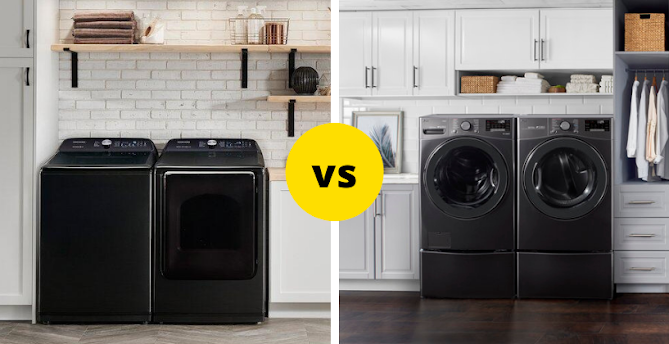A washing machine is one of the essential devices in any household in the laundry process. Two kinds of washing machines, top load, and front load have emerged due to the advancement of design and operation over the years. While both types of washing machines serve the same purpose, they differ in significant ways that can impact how you manage your laundry. In order to help you select the most suitable machine type to suit your needs, we'll look at the comparison between front-load and top load washing machines in this article.
Capacity
The capacity top-load and front-load washing machines provide among their major distinctions. Top load washing machines typically have more space and can accommodate more clothes in each load. This is because more clothes can fit into the vertical drum they are equipped with. However, front-load washing machines are of small capacity and typically can hold about 10 lbs in the laundry for each load. This is because the horizontal drums that have a lower capacity for clothes, however it is designed to be more energy efficient.
Water Usage
One of the major differences between front load and top load washing machines can be seen in the quantity of water utilized. In comparison to top load models, front load models use less water. This is because front load washing machines use less water to wash clothing by tumbling them. Top loaders, however require a large amount of water in order to fill up the drum, which can cause a rise in water prices. If you're worried about the environment, a front-load washing machine could be a better choice to protect the environment.
Energy Efficiency
Most front load washing machines are more energy efficient than top load machines. This is because they use less energy and water to run. Furthermore, since front load machines rotate faster, and the clothes come out from the machines with less water and are dry quickly. As time passes, this can yield substantial savings in energy and money.
Cleaning Performance
Washing Machines are front and top load used to clean clothes. However, they do this differently. Top load washing machines utilize an agitator, which is a central pole that rotates and rubs against clothes to eliminate grime and stains. However, front-load washing machines use an agitation motion that is gentle on clothing and is more effective in removing dirt and stains. Furthermore, they are able to spin faster and help in the removal of more water from clothing and accelerate drying.
Maintenance
Maintenance is an important aspect to consider when choosing between top-load or front-load washing machines. In comparison to top load machines front load machines require more maintenance. This is because front load washing machines have an airtight door seal made of rubber which, if not properly washed and dried following every use, could hold moisture and trigger the development of mold. Additionally, if the door and the detergent dispenser aren't often clean, washing machines that are front loading can begin becoming smelly. However, top loaders tend to be less troublesome to maintain because they need an airtight seal on the door which could collect moisture. To keep from the accumulation of detergent or fabric softener residue, it's important to clean the dispenser of detergent and the drum regularly.
Whatever equipment you decide to purchase, it is crucial to follow the maintenance and cleaning instructions. This will prolong the life and ensure your machine's efficient running.
Cost
Top Load Washing Machines tend to be cheaper than front-loaders in terms of cost. This is because top-loaders have been around longer and have a simpler design. Front load machines are more expensive since they have more advanced features like faster spin speeds and more energy efficiency. Front load washing machines can help you save money in the long run by using less electricity and water.
Accessibility
Compared to front loaders, top load washing machines are easier to use and have more accessibility. It's because they are easier to load and unload clothing. The drum is located high up on the unit. In contrast, front-load washing machines need users to lower themselves for loading and unloading their clothes which can be a challenge for some people, especially those with back issues.
Conclusion
In the end, both top load as well as front load washing machines provide advantages as well as disadvantages. Although top load machines typically cost less and have larger capacities than front-loaders, they consume more energy and water. However, front-load machines are expensive and require more maintenance, but they are more efficient in energy use and consume less water.
It's important to consider your individual needs and preferences when choosing between two types. A top load washing machine may be the best option for those with a large family and require lots of laundry due to its capacity increase. A front-loader could be the better choice, however, if you live in a smaller space and are concerned about electricity and water consumption.








0 Comments